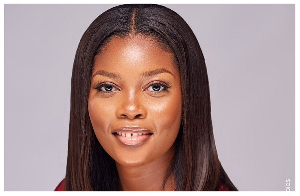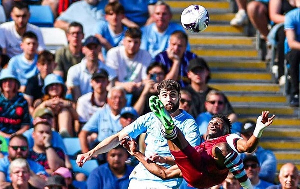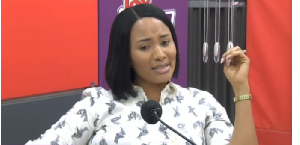- Home - News
- TWI News | TV
- Polls
- Year In Review
- News Archive
- Crime & Punishment
- Politics
- Regional
- Editorial
- Health
- Ghanaians Abroad
- Tabloid
- Africa
- Religion
- Election 2020
- Coronavirus
- News Videos | TV
- Photo Archives
- News Headlines
- Press Release
Business Features of Wednesday, 8 May 2024
Source: Audrey Safoaa Aikins, Contributor
Unravelling the puzzle of ownership in the era of AI
Picture this: you put in a couple of word prompts into a free Artificial Intelligence content generator and the system composes a song, produces an art-piece that is museum-worthy or engineers a revolutionary technology that can reshape an entire industry; does the produced work belong to the person who put in the prompt, the person who created the AI programme, or perhaps even the AI itself?
In the very recent years, there has been a shift from the traditional process of creating a “work” to a more modern one due to the introduction of AI tools such as ChatGPT, Gemini and Copilot. These tools have led to the churning out of “works” or creations at an incredibly high speed with extremely high artistic qualities and in vast quantities. The lines between human ingenuity and machine-generated output have been significantly blurred and the traditional notions of authorship or ownership are now being challenged.
This article discusses the intricacies of ownership within an AI-dominated era and highlights the struggle of intellectual property laws in adapting to technological progress.
THE QUESTION OF AUTHORSHIP BEFORE AI
Intellectual property laws have traditionally always presumed and required the human authorship of work in order to acquire an intellectual property right, enforce it or protect it. The laws have always been human centred and have been primarily concerned with protecting human creations and innovations.
In Ghana, the Copyright Act provides that the creations a person may possess a copyright over may include literary work, musical work, artistic work, audio-visual work, choreographic work, sound recordings, computer software, or inventions that are not anticipated by prior art. The law requires a “work” to be original, fixed in a tangible medium of expression and created by a person who is either a citizen or ordinarily resident in Ghana.
Where the creation is an invention, the Patent Act which provides the legal safeguard for inventions requires that the invention must be the idea of an inventor which permits, in practice, the solution to a specific problem in the field of technology. Although the Act gives no definition of who an inventor is, it is presumed that the law requires the inventor to be a person and that person must be identifiable.
The authorship of industrial designs has also been acknowledged by the intellectual property laws of Ghana. An industrial design is a composition of lines or colours, any three-dimensional form or any material, whether or not it is associated with lines or colours .
A textile design as an industrial design must have the composition, form or material that gives a special appearance to a product of industry or handicraft and can serve as a pattern for a product of industry or handicraft. Under the Industrial Designs Act, the right of registration resides in the person(s) who creates that industrial design.
Intellectual property rights exist also in trademarks according to the Trademark Act of Ghana. A trademark is a sign or combination of signs capable of distinguishing the goods or services of one undertaking from the goods and services of another undertaking.
Ghana's intellectual property framework centers the human creator by virtue of the fact that the Copyright, Patent, and Industrial Designs Acts vest authorship and ownership rights in the individual who brings a creative work into existence.
THE QUESTION OF AUTHORSHIP AFTER AI
The influx of AI generated works has made the once simple question of authorship a very difficult one to answer. AI can now write novels, compose music, write blockbuster movies and even mimic the likeness of human creators and artists. It is now very difficult to distinguish between what was AI- generated and what was made solely relying on human ingenuity.
As stated earlier, traditionally, copyright laws protected "original works of authorship," ; a concept that assumed human creation. Today, the ownership of an intellectual property has become a three-way battle amongst the Prompt giver, the AI programmer or even the AI itself . The question abound now is; whether the person who kicks off the process with a prompt or specific instructions owns the copyright; or if the person who built the AI's underlying code deserves ownership of an AI-generated work; or whether the AI tool itself should be considered an author with intellectual property rights as the capabilities of AI increase with time.
Resolving the issue gets even more complex when one considers the replication of a person’s likeness by generative AI apps. Where the likeness of an accomplished creator is used to create distinct artistic works, can that said creator say that he or she is entitled to any ownership or authorship rights even though the creation process was independent of them? OR can an artiste claim authorship on the grounds that their original work was used to train and generate a derivative work using Artificial Intelligence?
THE FUTURE OF AI AND OWNERSHIP OF WORK
With the progression of AI and the apparent effect it has on intellectual property rights, different schools of thoughts have made different arguments on the subject matter.
The first school of thought argues that AI simply regurgitates existing information and lacks human ingenuity. AI-generated content, in their opinion, is a derivative work and just a mere reflection of the data it has been trained on. This argument is based on the fact that without the provided data, the AI tool cannot provide any meaningful output or content. As such, they are of the belief that the authorship and ownership of any AI-generated work resides in the individual who gives the prompt to the machine.
The second school of thought shares the belief that AI produces work which has a level of originality that extends beyond the replication of data used by the AI tool for machine-learning. This school of thought is of the view that the “creative essence” reflected by AI’s output is enough to make the AI qualify as an author of a work vested with intellectual property rights. They argue that the output given by the AI is very distinct from any input used for machine learning. As such they of the belief that AI tools can have authorship and ownership rights.
Then, there is the third and probably final school of thought that believe that some authorship and intellectual property rights truly reside in the persons who create the AI tool and curate the data for the AI tool to use for machine learning. They argue that without the creation of the AI-tool and without the painstaking curation of data by the AI-tool creator, there would not be any avenue to create any of the works made using AI. They further state that the creators of AI tools should be recognised as co-authors, if not the actual authors, to any work that is AI-generated in order not to discount their contribution in the final output.
To perhaps kick it up a notch, an argument in favour of the creators of the data sourced and used to train these AI-tools may be made. A person may argue that these creators are the true authors of any AI-generated work if the generative AI tool simply utilizes their works and regurgitates it, in a minutely different way, as “new” content.
It is very difficult to align with any side of the argument because each school of thought proffers a valid point on how authorship and ownership of a work should be determined in AI dominant era.
THE WAY FORWARD IN GHANA
The Intellectual property laws of Ghana currently do not provide any real answers on how ownership and authorship should be determined because, as has been pointed out earlier, the legislations are human-centric and the drafters of these laws only envisaged human creators or inventors. The development of Artificial Intelligence highlights the gaping hole in the current legislations and the lack of clarity leaves a lot of issues unresolved and creates a lot of uncertainty for creators.
The deficiency in Ghana’s intellectual property laws, in my humble opinion, may be cured by revising the existing legislation to give co-authorship rights to the prompt giver and the creator of the AI tool or perhaps AI tool itself. To answer the question of how the interest can be shared, the laws may direct that allocation of authorship rights must be done in accordance with the rules of Equity.
Another suggestion to ensure that our laws take cognisance of the effect of AI on intellectual property rights may be that, authors of already existing works curated to train an AI tool can acquire co-authorship rights in works created by AI that replicate likeness of the said author. Our laws need to be amended to rid-off the constant requirement of a person.
In the interim however, our courts may purposively interpret our intellectual property laws to recognize the AI era in which we find ourselves. The state can also take advantage of the economic benefit of AI by creating a fund where proceeds from works or creations made autonomously by AI tools are channelled into. Royalties may even be paid from the fund to creators whose works have been used to train these AI tools.
It is about time that Ghana shifted from a human-centred intellectual property legislation regime to one that acknowledges the creation of content using artificial intelligence and creation of content autonomously by artificial intelligence.
CONCLUSION
The rise of AI has exposed the flaw in our intellectual property laws. Does ownership reside with the programmer who built the AI, the one who curates its training data, the person who inputted the prompt to receive a tailored response or the AI itself as a supposed creative entity? This conundrum has a lot of implications as unclear ownership or authorship rights create a legal gray area that leaves creators unsure of their rights. It is apparent that the lawmakers had only human creators in mind during the drafting of our intellectual property protection laws as it is very human-centric.
This has made it difficult to provide the much-needed answers to the burning questions on authorship and ownership in the AI era. Whether there will be an overhauling of the current legislation to take into account AI-generated content, or whether the courts in interpreting the concept of authorship will redefine these terms taking into cognizance the effect of Artificial Intelligence, may only be determined with time.











